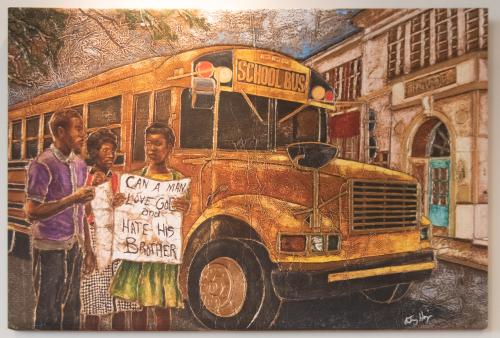Separate but Not Equal
In the pivotal case of Plessy v. Ferguson in 1896, the U.S. Supreme Court ruled that racially separate facilities, if equal, did not violate the Constitution. Segregation, the Court said, was not discrimination. It wasn’t until May 17, 1954, that the Supreme Court of the United States unanimously ruled that segregation in public schools was unconstitutional. The Court ruled that “separate is not equal,” and that segregation violated the Equal Protection Clause of the Fourteenth Amendment.
“Separate But Not Equal” painted by Anthony High literally asks the viewer to contemplate if man can love God but hate his neighbor. These poignant thought-provoking words emblazon a sign held by one of three African American children in the left foreground of this painting. Well dressed, they stand in front of a school bus devoid of driver and riders. Leafy trees and a cloudy blue sky pleasantly frame the work.
High’s unique artistic practice of incorporating his love of drawing and painting with printmaking lends a timeless quality to his work. This style, called collagraphy, combined with a highly saturated palette, results in a work fraught with tension and uneasiness. An imposing and intimidating school building looms in the background. The viewer is left to ponder additional pertinent questions: will these three African American students be allowed to attend school? Will they be afforded the same opportunities so freely provided to white children? Why have we as a society been unable to find a tangible end to race-related disparities? More importantly, what can I do to help end systemic racism?


